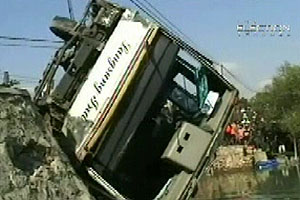
An operator displays a handful of corn at an ethanol plant. Photograph: Mark Blinch/Reuters
· 25% of US corn crop already used for biofuel
· Texas governor wants biofuel target cut by 50%
· Barack Obama wants big increase to 60bn gallons
Elana Schor in Washington
guardian.co.uk,
Wednesday August 06 2008 10:48 BST
The moment of truth is at hand for US biofuels this week as environmental regulators prepare to rule on one state’s request to halve the steep national target for blending ethanol into fuel.
Texas governor Rick Perry asked the US environmental protection agency (EPA) in April to cut the national biofuels target 50% from its current level of 9bn gallons. After an unexpected delay last month, the EPA is expected to rule on Perry’s waiver request as soon as this week.
The waiver proposal has stoked a fierce political row over the future of biofuels, with some US politicians echoing their European counterparts in questioning whether ethanol’s effect on food prices limits its usefulness as an alternative to traditional fuel.
“We need to put an end to flawed government policies that distort the markets, raise food prices artificially, and pit producers against consumers,” senator John McCain said in May after he and 23 fellow Republicans endorsed an easing of the ethanol target.
Three major environmental groups have even sided with the conservative governor – albeit with different motives than Perry, who sought the waiver to protect Texas livestock producers from rising corn prices.
Suspending the biofuels target would allow the EPA the environmental sustainability of increased ethanol production, according to Friends of the Earth energy policy campaigner Kate McMahon.
“This biofuels mandate essentially dictates inaction on climate change by taking us in a useless and potentially harmful direction,” McMahon said in a statement last month.
Yet powerful supporters of increased ethanol production hail from nearly every corn-producing state in the US, including an Illinois senator named Barack Obama. In his energy plan released this week, the Democratic presidential nominee sets a 60bn-gallon target within 22 years for advanced biofuels, including cellulosic ethanol.
The ethanol industry’s US trade group, the Renewable Fuels Association (RFA), asserts that the carbon footprint of ethanol – already lower than that of conventional petrol – will only decrease as the ethanol target encourages the development of advanced biofuel.
“We’re doing everything we can, as efficiently as we can, to bring those technologies to the marketplace,” RFA spokesman Matt Hartwig said.
“But if you go in and undermine the foundation of the ethanol industry today, you’ll set back the development of those next-generation technologies.”
That more and more US corn is being diverted to make ethanol is not in dispute. The US agriculture department estimates that 25% of the nation’s corn crop, valued at $52.1bn, was used for fuel last year. That number could rise as high as 35% this year.
But the ethanol industry argues that high oil prices, not biofuels, are to blame for food prices that have risen far faster than inflation.
Only one-quarter of recent US corn price increases are attributable to the ethanol tax credit – recently reduced by Congress from 51 cents to 45 cents per gallon – according to a Purdue University study commissioned by the Farm Foundation.
A confidential World Bank report obtained by the Guardian last month, however, tagged biofuels as the cause of a 75% rise in worldwide food prices.
The EPA’s delay in ruling on the Texas waiver request, which sparked more than 15,000 public comments to the agency, raised concerns among those on both sides of the biofuels battle.
Eight senators from corn-producing states publicly warned EPA administrator Stephen Johnson against “any agreements being made behind closed doors”.
Meanwhile, some commodity watchers predicted that falling corn prices this summer would give the agency grounds to deny the waiver.
No matter what the EPA decides in coming days, the battle may not end right away. Biofuels supporters are likely to challenge any potential waiver in court, and Perry appears to have laid the groundwork for a lawsuit against the agency if his request is denied.
According to Carbon Control News, Perry wrote in comments to the EPA that the law requires a waiver of the ethanol target “whenever [Johnson] is able to make a reasonable determination that a major sacrifice would flow from the implementation of the mandates”.
Source : guardian.co.uk



